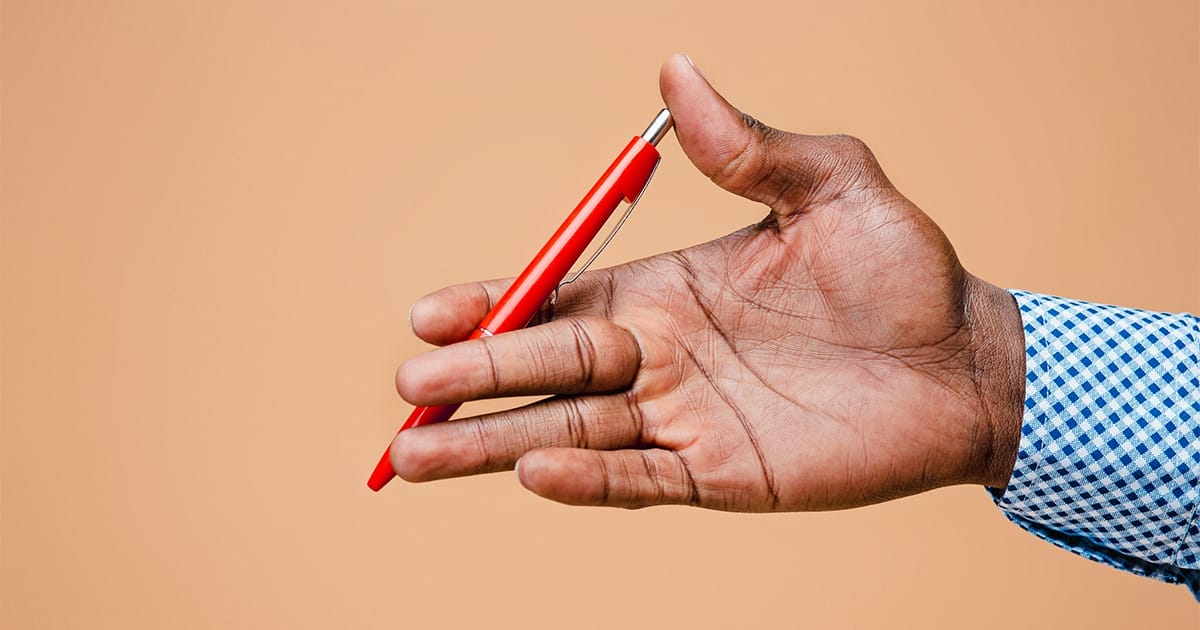Writers write, right? They spend their days drafting, rewriting, and finalizing and their nights dreaming about perfectly crafted sentences and what’s next. But what writers may not realize is if they go too long without a break, they’ll show signs of their dedication with a writer’s callus.
If you prefer writing outlines and drafts by hand, you may have experienced a writer’s callus before. Also known as nerd bump or writer’s bump, these calluses are caused by repeated use of a writing utensil.
Disclaimer: This is a writing blog and we do not offer professional medical advice. If you’re dealing with writer’s callus or some other condition please consult your doctor for the best course of treatment.
Table of Contents
What is a Writer’s Callus?
According to Healthline, “writer’s callus is an area of accumulated dead skin cells that form as a result of repeated friction against your finger.” If you primarily type rather than use a pen or pencil, this type of callus may not be a problem. However, if you do find yourself writing longform for stretches of time, then this is something to watch for!
Think of a writer’s callus as similar to a blister forming on your foot after wearing new shoes for a while. Your skin isn’t used to the friction and as a protection measure, your body forms a blister. A writer’s callus forms on your hand for the same reason—your body is protecting that part of your hand from damage by forming a bump.
Where Can Writer’s Calluses Occur?
Musicians who play stringed instruments often experience calluses on their hands. Guitarists and violinists frequently build calluses where their fingers press against the strings.
If you engage in strength training, you can probably feel the calluses on the soft skin on the underside of your knuckles where you regularly grip your weights.
A writer’s callus can occur on your hand wherever your writing utensil rubs repeatedly. Where the callus appears depends on how you hold your writing utensil. Some people hold their pen or pencil between their index and middle finger while others rest it against their ring finger.
How to Prevent a Writer’s Callus
There are many ways you can work to prevent a writer’s callus before it starts. Here are a few common suggestions to try.
Wear Gloves While Writing
Lightweight cotton gloves add a layer between your pen and your hand, reducing the friction created from writing. People often wear gloves while raking leaves or lifting weights for this reason, so why not try it for writing as well?
Take Short Breaks
Short breaks are helpful for many reasons, and one reason is it gives your hands a break. While it’s easy to get into the zone and not want to break the spell, it’s a good idea to take regular breaks to move around, stretch, refill your drink, and then get back to work.
Treat Writing Like a Job
If you don’t yet write full time, try to treat it as if you do. Think about how a day job works—you have regular breaks scheduled throughout the shift, a lunch break, and a quitting time. There’s space between working and not working. There are two full days off each week. Having a schedule for writing (with planned breaks and time off) can also help in preventing calluses from forming.
Set Aside Your Favorite Pen
Drastic, I know. Most of us have a favorite writing utensil. Whether it’s a pen we think makes our handwriting look better, or a type of ink that doesn’t smear (I’m talking to you, lefties!), writers are notorious for keeping favorites close. However, switching up the type of pen you’re using to write throughout the day can actually help slow or prevent the form of calluses. Just something to consider.
Mix it Up
If you’re on deadline or have high daily word count goals, then it may be prudent to plan for many writing methods. For example, plan to write freehand for your first block of writing, use speak-to-text software for your second block, typing into a computer for your third block, etc.
I Have a Writer’s Callus, Now What?
Once you have a callus, there are a few things you can do to treat it according to the American Academy of Dermatology Association.
- Soak in warm water
- File with a pumice stone
- Moisturize
Keep in mind that your callus has formed because your body is trying to protect the skin underneath it from the pressure of your pen. If you are going to continue writing by hand then you may want to keep the callus until you’re ready to take a longer break.
I say, if you have a writer’s callus then wear it as a badge of honor! It shows that you’re dedicated to your craft.
Commitment to a dream is often the difference between seeing that dream come to fruition, or watching that dream remain dormant. If it takes a few calluses to push your dream into reality, it’s well worth it.
Happy writing, and don’t forget to change up your routine every now and then!







